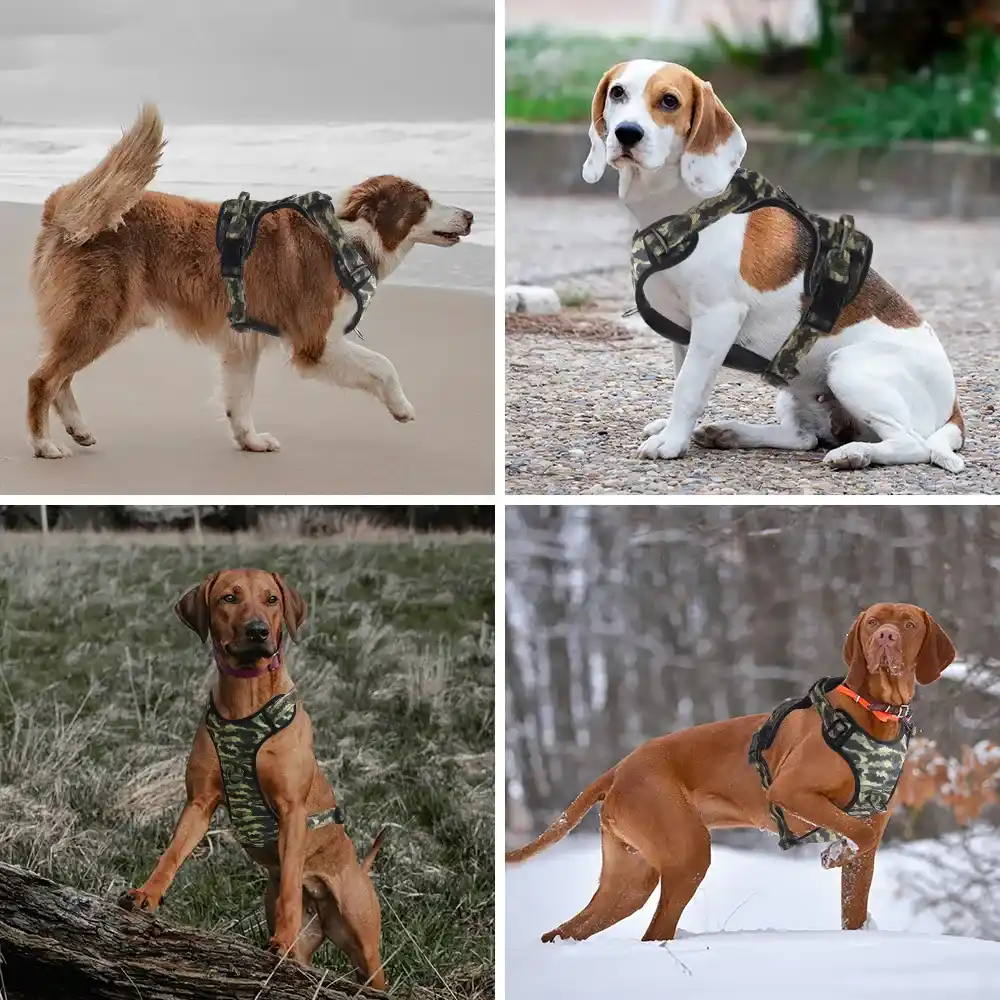Compared to ordinary dogs, pet owners have higher requirements for dog harnesses when managing reactive dogs to ensure safety and comfort during walks. Reactive dogs are more likely to be frightened and struggle violently during daily outings, potentially leading to severe skin friction or even escape. Therefore, determining whether dog harnesses are safer and more comfortable for dogs than other tools is a primary issue that dog owners consider.
Harnesses are often recommended for reactive dogs as they provide greater control and minimize the risk of neck strain compared to traditional collars, making them essential for maintaining safety and comfort.
Let’s explore why a harness, particularly a well-designed model like the QQPETS Reflective No Pull Tactical Dog Harness, might be the optimal choice for your reactive furry friend, and how it can transform your daily walks into more peaceful outings.
Why Are Dog Harnesses Preferred Over Collars for Reactive Dogs?
Harnesses offer distinct advantages over collars, particularly for dogs that might react unpredictably to their environment.
Enhanced Control and Safety:
- Distributed Pressure: Unlike collars, which concentrate pressure around the neck, harnesses distribute it across a broader area of the body, reducing the risk of injury during sudden movements.
- Reduced Choking Risk: Harnesses eliminate the risk of choking associated with collars, which is crucial for dogs that pull or lunge.
Improved Behavior Management:
- Directional Guidance: Harnesses, especially those with front clips, allow for more effective directional control, helping to manage and train reactive dogs by gently guiding them rather than pulling them back.
What is the Best Dog Harness for Reactive Dogs?
Selecting the right harness is crucial for ensuring it provides the intended benefits without causing additional stress or discomfort.

The QQPETS Reflective No Pull Tactical Dog Harness – A Top Choice:
- Optimal Control: With front and back leash attachment points, this harness offers versatile handling options, allowing for both training and casual walking setups.
- Comfort and Durability: Designed with a strong outer layer and a breathable mesh inner lining, it ensures comfort even during extended wear, while the robust construction withstands the rigors of active use.
- Adjustability for Perfect Fit: Four points of adjustment ensure a snug fit that conforms to your dog’s body, minimizing the chance of slipping out or discomfort.
- Visibility and Safety: Reflective trim enhances visibility during night walks, adding an extra layer of safety for you and your dog.
How Do Harnesses Help Manage Reactivity?
Harnesses can play a crucial role in behavior management strategies for reactive dogs by providing the necessary tools for effective training and control.
Behavioral Training Support:
- Non-restrictive: Allows for the use of positive reinforcement training techniques without causing discomfort or pain that could exacerbate reactive behaviors.
- Directional Steering: Some harnesses feature front attachment points, making it easier to guide your dog away from triggers and teach better walking etiquette.
How to Choose the Right Harness for Your Reactive Dog?
Selecting the right harness is crucial for ensuring it benefits your reactive dog without causing additional issues.
Considerations for Fit and Comfort:
- Accurate Sizing: Ensure the harness fits well without being too tight; an ill-fitting harness can be uncomfortable and counterproductive.
- Adjustability: Look for harnesses with multiple adjustable points to achieve a snug fit that allows full range of motion.
Can a Harness Replace Good Training?
While harnesses are helpful, they are most effective when used in conjunction with consistent training methods.
Integrating Training with Harness Use:
- Consistent Practice: Regular training sessions using the harness can reinforce calm behaviors and gradual desensitization to triggers.
- Professional Guidance: Consider working with a professional dog trainer who can provide personalized advice and techniques tailored to your dog’s specific reactivity issues.
Conclusion
Harnesses can indeed be a boon for managing reactive dogs, offering enhanced control, safety, and support for behavioral training. By choosing the right type of harness and combining its use with effective training strategies, you can help your reactive dog become more comfortable and confident during walks.
QQPETS is the leading wholesale dog harness manufacturer of adjustable harnesses for dogs and other items that people may use when walking their dogs. Our goal is to make dog walking easy for pet owners by providing valuable accessories. We offer a variety of customization services including custom logos, custom graphics, custom products and more. If you want to start your dog products business, check out our website and contact us today.
FAQ about dog
What tools are good for reactive dogs?
- Head Collars: Such as the Gentle Leader, can provide better control over the dog’s head and direction, making it easier to redirect attention away from triggers.
- No-Pull Harnesses: Especially those with front-clip options like the Easy Walk Harness, help manage pulling and provide more control without causing discomfort.
- Martingale Collars: Offer more control than standard collars and are less likely to slip off, which is particularly useful for dogs that might try to back out of a collar when startled or scared.
Do harnesses make dogs calmer?
Harnesses themselves do not inherently calm dogs, but they can reduce anxiety related to neck pressure and discomfort caused by collars. By distributing pressure more evenly across the chest and back, harnesses allow dogs to feel more comfortable during walks, potentially reducing reactive behavior linked to physical discomfort.
Do dogs behave better with a harness?
Many dogs do behave better with a harness, especially if they are prone to pulling or if they have respiratory or tracheal issues. Harnesses can provide better control for the owner without the risk of choking, which can lead to a more relaxed and manageable walking experience. However, the effectiveness can vary based on the individual dog and the type of harness used.


